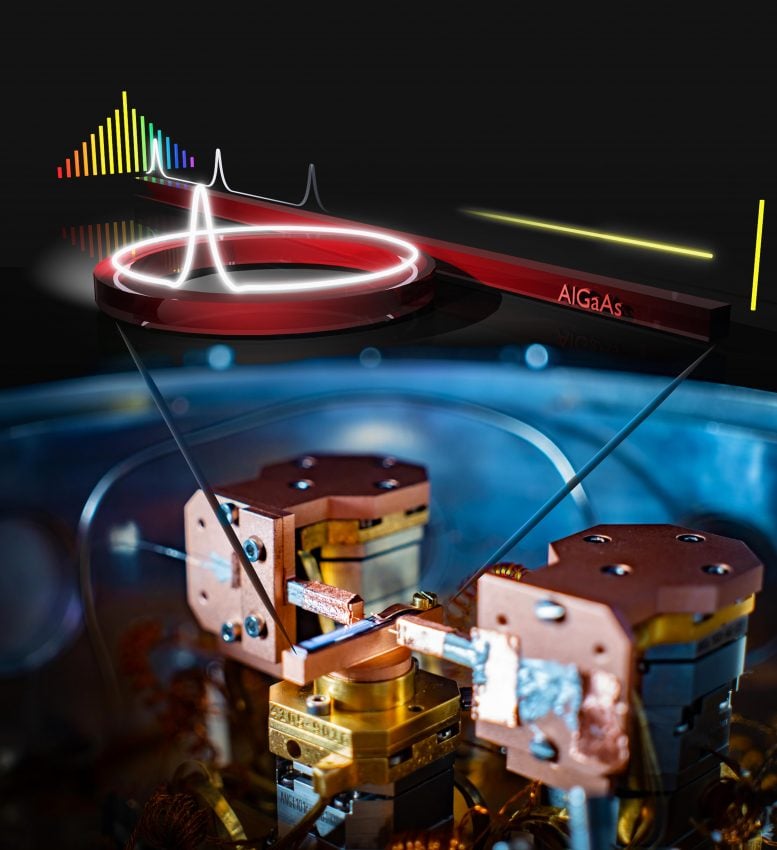
Experimental setup to generate a set of stable frequencies in a cryogenically cooled laser microresonator frequency comb. The ring-shaped microresonator, small enough to fit on a microchip, operates at very low laser power and is made from the semiconductor aluminum gallium arsenide. Credit: NIST
Just as a meter stick with hundreds of tick marks can be used to measure distances with great precision, a device known as a laser frequency comb, with its hundreds of evenly spaced, sharply defined frequencies, can be used to measure the colors of light waves with great precision.
Small enough to fit on a chip, miniature versions of these combs — so named because their set of uniformly spaced frequencies resembles the teeth of a comb — are making possible a new generation of atomic clocks, a great increase in the number of signals traveling through optical fibers, and the ability to discern tiny frequency shifts in starlight that hint at the presence of unseen planets. The newest version of these chip-based “microcombs,” created by researchers at the National Institute of Standards and Technology (NIST) and the University of California at Santa Barbara (UCSB), is poised to further advance time and frequency measurements by improving and extending the capabilities of these tiny devices.
At the heart of these frequency microcombs lies an optical microresonator, a ring-shaped device about the width of a human hair in which light from an external laser races around thousands of times until it builds up high intensity. Microcombs, often made of glass or silicon nitride, typically require an amplifier for the external laser light, which can make the comb complex, cumbersome and costly to produce.
The NIST scientists and their UCSB collaborators have demonstrated that microcombs created from the semiconductor aluminum gallium arsenide have two essential properties that make them especially promising. The new combs operate at such low power that they do not need an amplifier, and they can be manipulated to produce an extraordinarily steady set of frequencies — exactly what is needed to use the microchip comb as a sensitive tool for measuring frequencies with extraordinary precision. (The research is part of the NIST on a Chip program.)
The newly developed microcomb technology can help enable engineers and scientists to make precision optical frequency measurements outside the laboratory, said NIST scientist Gregory Moille. In addition, the microcomb can be mass-produced through nanofabrication techniques similar to the ones already used to manufacture microelectronics.
The researchers at UCSB led earlier efforts in examining microresonators composed of aluminum gallium arsenide. The frequency combs made from these microresonators require only one-hundredth the power of devices fabricated from other materials. However, the scientists had been unable to demonstrate a key property — that a discrete set of unwavering, or highly stable, frequencies could be generated from a microresonator made of this semiconductor.
The NIST team tackled the problem by placing the microresonator within a customized cryogenic apparatus that allowed the researchers to probe the device at temperatures as low as 4 degrees above absolute zero. The low-temperature experiment revealed that the interaction between the heat generated by the laser light and the light circulating in the microresonator was the one and only obstacle preventing the device from generating the highly stable frequencies needed for successful operation.
At low temperatures, the team demonstrated that it could reach the so-called soliton regime — where individual pulses of light that never change their shape, frequency or speed circulate within the microresonator. The researchers describe their work in the June issue of Laser and Photonics Reviews.
With such solitons, all teeth of the frequency comb are in phase with each other, so that they can be used as a ruler to measure the frequencies employed in optical clocks, frequency synthesis, or laser-based distance measurements.
Although some recently developed cryogenic systems are small enough that they could be used with the new microcomb outside the laboratory, the ultimate goal is to operate the device at room temperature. The new findings show that scientists will either have to quench or entirely avoid excess heating to achieve room-temperature operation.
Reference: “Dissipative Kerr Solitons in a III‐V Microresonator” by Gregory Moille, Lin Chang, Weiqiang Xie, Ashutosh Rao, Xiyuan Lu, Marcelo Davanço, John E. Bowers and Kartik Srinivasan, 22 June 2020, Laser & Photonics Reviews.
DOI: 10.1002/lpor.202000022


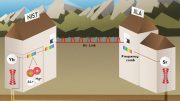

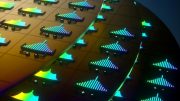

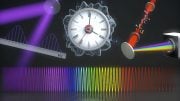
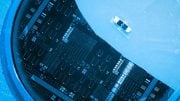
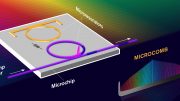
Thanks for the article!
The article suggests that since mass production can be used to produce the microresonator, it would be inexpensive, but it wasn’t clear if a 4K degree cryostat would be needed for a more widely used product. It seems keeping such low temperature would make it expensive!
Thanks bro!